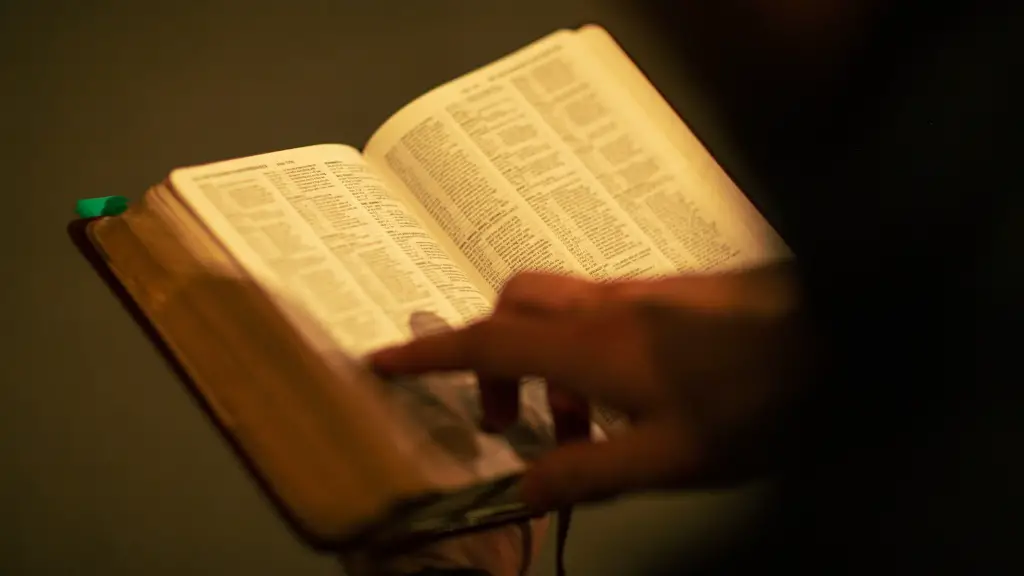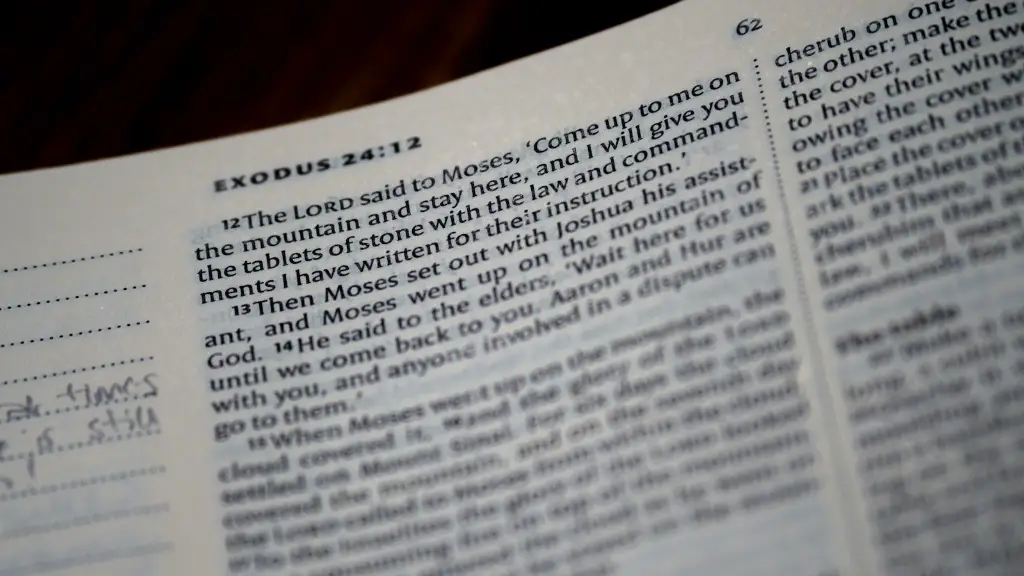Background of Lent
Lent is a special time in the Christian church, especially within the Western church calendar. It is a period of fasting and reflection on the stories from the New Testament. Lent is traditionally a time of self-examination and repentance prior to Easter, and lasting for 40 days, hence sometimes being called the “forty days of Lent.” It follows the six Sundays of Epiphany and usually begins on Ash Wednesday.
Lent is associated with the practice of Lenten fasting, in which certain types of food prohibitions and restrictions are observed. The Bible does not actually mention Lent as an observance, but it does express the idea that fasting should be done in a holy and God-fearing manner. The origin of the term “Lent” comes from the Old English word “lencten”, meaning “spring”.
Biblical Lessons for Lent
The Bible has many stories about Jesus’ life and ministry, and these stories serve as reminders for us as we reflect on our lives during Lent. For example, Jesus shared a message of hope and redemption when He healed the sick, welcomed outsiders, and challenged injustice. He showed us to be faithful during times of difficulty and to stay true to our beliefs. Moreover, Jesus taught us the importance of prayer and of personal integrity in our journey of faith.
One of Jesus’ most memorable moments is found in Luke 4:1–8, telling of Jesus being tempted in the desert. In this passage, Jesus was tested with three temptations, and He responded by referring to the scriptures. In this, Jesus shows us the importance of turning to God in times of struggle. Ultimately, Jesus succeeded in holding on to his faith.
The forty days of Lent is meant to be reflective of Jesus’ forty days in the desert, fasting and being tempted. This period should be used as an opportunity to give up something that interferes with our relationship with God, and focus instead on Him.
Passover and Easter Relationships
The forty days of Lent mimic the forty years that the Israelites spent wandering in the desert upon their exodus from Egypt. This event is known as the Exodus and is celebrated during the Passover holiday in the Jewish tradition.
Easter is the holiest time in the Christian Church, and is celebrated in the Western half of the Church on the day Jesus rose from the dead, in commemoration of His resurrection. Easter is observed after the forty days of Lent and happens at a different time each year, depending on the Lunar cycle.
Both Passover and Easter are associated with reflection, repentance and redemption. Both emphasize the grace, mercy and power of God and provide believers with a new hope and beginning.
Church Celebrations
Most churches observe Lent in one of two ways, either a solemn and somber occasion or a joyous celebration of Jesus’ resurrection. Lent is a period of reflection and remembrance, where believers read scripture, voluntarily forgo or “give up” something of value, and contemplate the meaning of Jesus’ death. The liturgy of Lent usually consists of fasting, prayer, and alms giving, with Ash Wednesday and Good Friday being especially significant days of fast, service, and worship.
The celebration of Easter is the most significant event in the Christian calendar, and is celebrated with joy and adoration. Many churches celebrate a service on Easter Sunday, where traditional hymns are sung, readings are read, and special sermons are preached. The joy continues during the Easter season, which lasts fifty days and ends with Pentecost Sunday.
Meaningful Practices
Lent is a time of spiritual renewal, a time of reconciliation with God, and a time of repentance and confession. It is a time to meditate and reflect upon Jesus’ suffering and death, as well as our own sinfulness. Each day of Lent focuses on a different aspect of Jesus’ ministry and encourages believers to reflect on the meaning behind it. During the Lenten season, Catholics often pray the Stations of the Cross, and many Christians fast on Ash Wednesday and Good Friday. Lent is also a time to renew our commitment to prayer and to Christ, and to intentionally spend more time with God.
Recognising Emotional Triggers
Lent is a special time to recognize the emotional triggers that can lead to Sin, such as anger and envy. During times of temptation, believers can look to Jesus for an example of how to fight these emotions, and draw strength from His faithfulness. As believers reflect on Jesus’ journey during Lent, they connect with His suffering, and develop a stronger relationship with Him.
Emotional triggers can also cause us to make the wrong decisions on our spiritual journey, so it is important to be aware of them and to constantly check our behaviour. Lent is a time to be introspective and to grow in our personal relationship with God. We can develop this relationship through prayer, meditation and reading the Bible, understanding that no matter how far we stumble, we can always make our way back to God.
Integrating Faith Into Practice
Lent is a time for believers to integrate their faith into everyday life and to recognize the importance of doing good deeds for the needy and for society. Lent is often used as an opportunity to remember the poor, those in need and those who have suffered injustices, such as racial or gender prejudice. During Lent, believers are encouraged to perform acts of charity, mercy and justice, and to be mindful of those who are less fortunate.
Moreover, Lent is a time to be intentional in our efforts to show love, kindness and courtesy to others. Believers should reflect on Jesus’ command to “love your neighbour as yourself” (Matt 22:39). This requires us to seek opportunities to serve and show kindness to our neighbours, friends and family.
A Time For Creation
The season of Lent is also a time for creation. It is a time to make art and to explore new ideas and ways of expressing our faith. It is a time of new growth and transformation, and an opportunity to step outside of our comfort zones and explore possibilities we might never have considered before.
Crafts such as pottery or candle-making can be excellent ways to reflect on the stories and parables of the Bible. Images and phrases written on paper can be stitched together to form banners and hung in the home to reflect on throughout Lent. These creative endeavors can add a fresh perspective to our Christian journey, and can be meaningful and lasting ways to show our faith.
Being Mindful of Environment
Lent is an opportunity to be mindful of our environment and to be aware of our impact on the planet. As we repent and confess our sins, we should be aware of the global ecological crisis. Our first responsibility is to care for the earth, and to consider the future of God’s creation. In order to become better stewards of God’s creation, believers can start by making small changes, such as reducing water and energy use, or supporting local and organic farming.
Environmental awareness also requires us to be aware of the consequences of our actions, such as deforestation and pollution. Believers can become more informed about the issues affecting our global environment, such as climate change and poverty, and take steps to act on those issues in their own lives.
Modern Ways to Participate
In modern times, technology can provide ways for believers to participate in Lenten activities and to stay connected during this time of spiritual reflection. Through online Bible study groups and online Lenten reflections, Christians can remain connected, while still respecting the practices of Lent.
Online prayer services and services of confession can also provide opportunities to remain connected and still keep Lent. Ultimately, Lent is an important spiritual time of self-reflection, which technology can facilitate without disrupting the spirit of this sacred season.
Celebrations Post-Lenten
The liturgical season following Lent is called Eastertide, and is a period for celebration of Jesus’ Resurrection. As we emerge from the solemnity of Lent, we can join with churches all around the world to celebrate Jesus’ Resurrection and triumph over death.
During Eastertide, believers celebrate the victory of Jesus over death and reflect on His teachings. Churches often hold special services, such as Easter Sunday Worship, Easter Vigil and Sunrise Services. During this time, believers sing alleluias and receive communion as they celebrate Jesus’ victory over death.
Moreover, many churches during Eastertide incorporate special music, decorations, and traditional gospel readings into their services. This includes traditional Easter hymns and psalms, such as Psalm 118:1-2 (KJV):”O give thanks unto the Lord; for he is good: because his mercy endureth for ever.”
Lent and Perspective
Lent is an important and meaningful time in the Christian faith. It is a time to reflect on the stories of Jesus, to recognize the emotional triggers that can lead us to sin, and to draw closer to God. It is a special time to integrate our faith into our practice, be mindful of our environment, use modern technology to connect, and celebrate Jesus’ resurrection after the period of Lenten observance. Ultimately, the season of Lent is a time of preparation and a renewal of our relationship with God.



